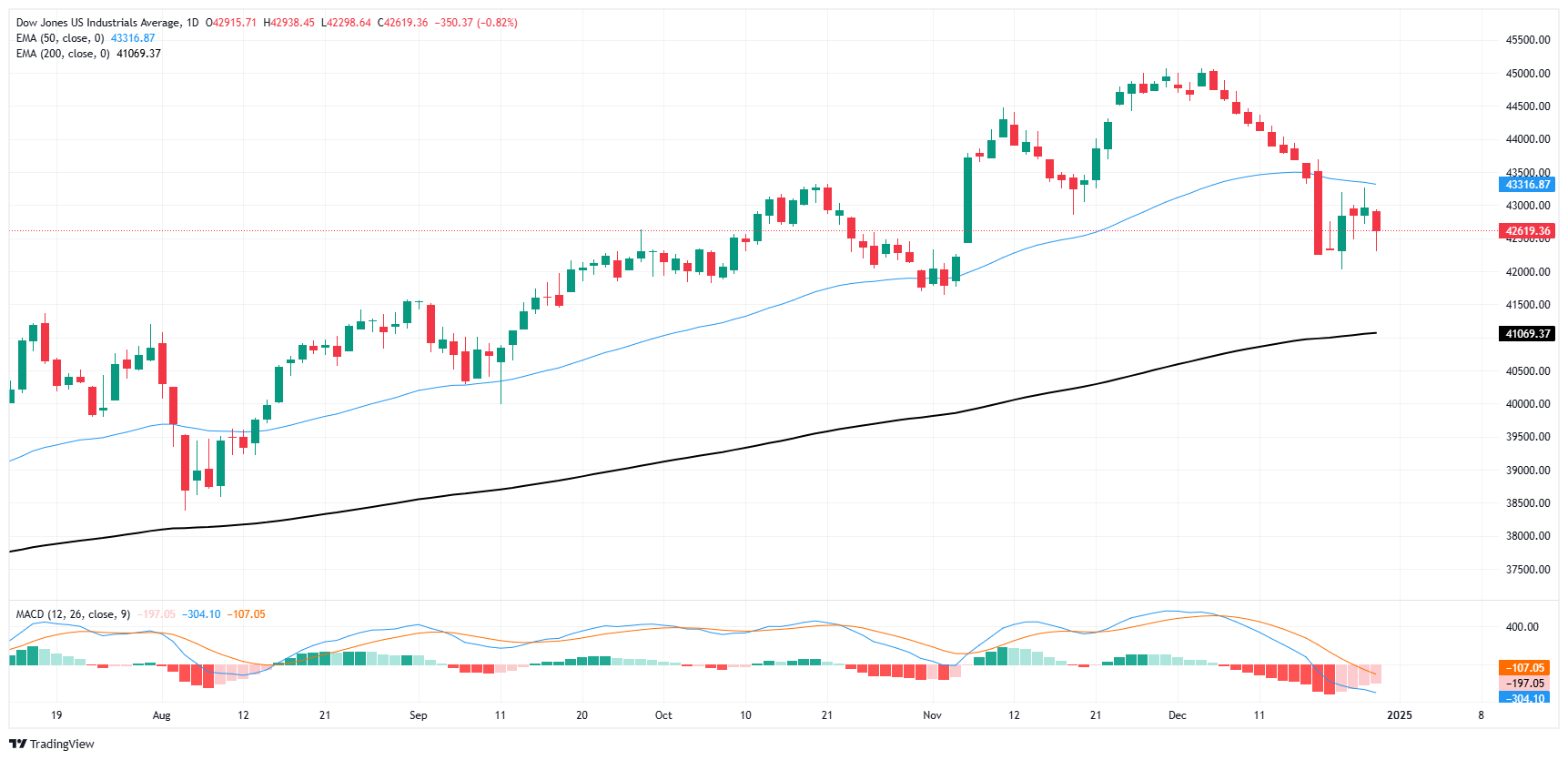- The Dow Jones lost 300 points on Monday as investors retreat into the end of the year.
- The broad-market tech rally that propelled indices to all-time highs in 2024 appears about to evaporate.
- Most investors are on the sidelines ahead of the midweek holiday shutdown.
The Dow Jones Industrial Average (DJIA) lost more than 300 points on Monday, falling to a short-term low just south of 42,300 before a half-hearted recovery back to 42,500 as stocks tumbled in one of the last days of negotiation of the year. The broad-market tech rally, fueled to dizzying heights by even higher investor expectations for an AI-powered future, appears poised to drain markets for the time being.
Markets are heading into the new trading year on a decidedly softer footing. The Dow Jones is down 5.5% from the all-time highs set in late November following a two-week period of consecutive daily declines, a feat the index has not accomplished since the 1970s. Markets hit the season holiday in a flat spiral, keeping the Dow Jones from further declines but also preventing a significant bullish recovery.
After the market closes midweek for the New Year’s holiday, traders will return en masse to a much more difficult environment than they expected for most of 2024. The Federal Reserve (Fed) has restricted the number of cuts rate cuts it expects to make in 2025, forecasting just two 25 basis point rate cuts during the calendar year before pausing. Despite the Fed’s insistence that its approach to interest rates remains ‘data dependent,’ investors will find it hard to believe that incoming President Donald Trump’s strategy of starting a trade war with everyone at once time will not have at least a marginal impact on the Fed’s policy stance.
Dow Jones News
The Dow Jones is broadly lower on Monday, with all but one of the stocks listed on the index trending red on the day. Nvidia (NVDA) is the only bright spot on the DJIA, rising just over 2% and touching $140 per share. On the downside, Boeing (BA) and Nike (NKE) are in a tight race to the bottom, both losing about 1.7% since the day’s opening bell. Boeing has fallen below $178 per share while Nike is testing $75 per share after falling to four-week lows.
Dow Jones Price Forecast
The Dow Jones’ recent decline from all-time highs has left the short-term price action struggling on the charts below the 50-day exponential moving average (EMA), a moving average that has provided technical support for bids over the last few years. last 13 consecutive months. Prices still hold north of the key 42,000 level, but bullish momentum remains limited as bids remain stuck below the latest low at 43,000.
Dow Jones Daily Chart
Dow Jones FAQs
The Dow Jones Industrial Average, one of the world’s oldest stock indices, is made up of the 30 most traded securities in the United States. The index is weighted by price rather than capitalization. It is calculated by adding the prices of the securities that comprise it and dividing them by a factor, currently 0.152. The index was founded by Charles Dow, also founder of the Wall Street Journal. In recent years it has been criticized for not being sufficiently representative, since it only follows 30 companies, unlike broader indices such as the S& P 500.
There are many factors that drive the Dow Jones Industrial Average (DJIA). The main one is the aggregate performance of its component companies, revealed in quarterly corporate earnings reports. US and global macroeconomic data also contribute, influencing investor sentiment. The level of interest rates, set by the Federal Reserve (Fed), also influences the DJIA, as it affects the cost of credit, on which many companies largely depend. Therefore, inflation can be a determining factor, as well as other parameters that influence the decisions of the Federal Reserve.
The Dow Theory is a method for identifying the main trend of the stock market developed by Charles Dow. A key step is to compare the direction of the Dow Jones Industrial Average (DJIA) and the Dow Jones Transportation Average (DJTA) and only follow trends where both are moving in the same direction. Volume is a confirmation criterion. The theory uses elements of maximum and minimum analysis. The Dow theory proposes three phases of the trend: accumulation, when the smart money begins to buy or sell; public participation, when the general public joins the trend; and distribution, when the smart money abandons the trend.
There are several ways to trade the DJIA. One of them is to use ETFs that allow investors to trade the DJIA as a single security, instead of having to buy shares of the 30 companies that comprise it. A prominent example is the SPDR Dow Jones Industrial Average ETF (DIA). Futures contracts on the DJIA allow traders to speculate on the future value of the index, and options provide the right, but not the obligation, to buy or sell the index at a predetermined price in the future. Mutual funds allow investors to purchase a portion of a diversified portfolio of DJIA securities, providing exposure to the global index.
Source: Fx Street
I am Joshua Winder, a senior-level journalist and editor at World Stock Market. I specialize in covering news related to the stock market and economic trends. With more than 8 years of experience in this field, I have become an expert in financial reporting.







